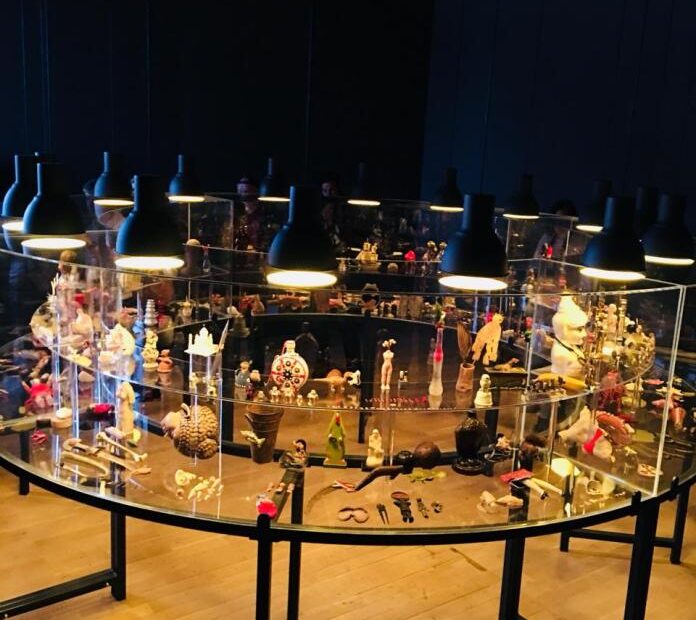On the occasion of unveiling his donation of Indian artist Mithu Sen’s whimsically nostalgic installation Museum of Unbelongings to the Kunstmuseum Wolfsburg as a part of their permanent collection, collector Durjoy Rahman announces the opening of his art foundation, Durjoy Bangladesh.
TEXT: CoBo Editorial Force
IMAGES: Courtesy of Durjoy Bangladesh

Mihtu Sen’s Museum of Unbelongings marks the first acquisition by a German institution of a work by a female South Asian artist. While some find this surprising, Durjoy Rahman, a Bangladeshi art collector who donated the work recognises the comparative lack of awareness of South Asian artists and their works in an international context, particularly the West. It is on this premise he established his new art foundation, Durjoy Bangladesh, which strives to promote art form South Asia and develop a critical discourse exploring cross cultural exchange. Affable, hospitable, and an avid art collector, Durjoy Rahman and his foundation advisor, the highly knowledgable Thomas Berghuis, discuss with CoBo the role of art foundations in art ecosystems, particularly those founded on the basis of cross cultural exchange.
Why are you setting up the foundation and why specifically in Berlin?
Berlin is an international art hub, and while it is a very big urban city, it has a charm which attracts creative people from around the world. When I decided to establish Durjoy Bangladesh Foundation, I thought that Berlin would be a good place, as the inspirations and ambitions of artists from South Asia, and beyond, could connect and build from it’s international reputation. I feel that the artists who we support can establish their art practice in an ideal context, and can resonate with Berlin’s international character.
So, it is more about creating and fostering network, an exchange of sorts?
Durjoy: It is, art is all about creative networks.
Thomas: I also think that the network in Berlin exists. There is a very strong art scene here, but also an artist led scene, and maybe that perspective of really art led by artists is something that can always develop further. When we talked about coming together on Durjoy Bangladesh, Durjoy mentioned one thing which is the idea of a movement in art and I think that is what Berlin is as well. It is known as other big cities are for it’s art galleries and museums, but also the movement of artists and art that is produced here, and how it links internationally is an important part of that work we become involved in.
Durjoy: Additionally, my art advisor, Martha (Gynp) is based here. And Thomas, who has vast experience working with different public and private institutions, lives close by in Amsterdam. So, it (Berlin) has a network, connection and resources. I find Berlin to be perfect point of optimisation.
What gravitated you towards collecting?
: My business is in textile and garment trading. I started travelling when I was very young because of my work, and when I started travelling to Europe and America I found the importance of all sorts of creative fields, not only art. I got interested in art because I’m a big fan of graphics, in particular photography and paper cuttings. In my profession, we use a lot of graphics for garments. Initially, when I started collecting I started with graphics from our workplace. Our first office used to be around the gallery district, and during my lunch break I used to gallery hop, which inspired and shaped my collection back in 1997.
What are your plans the foundation? Are there any upcoming projects, how do you aim for it to function?
Durjoy: This month we are celebrating the successful donation of Mithu Sen’s work, Museum of Unbelongings to the Kunst Museum Wolfsburg. Then, in December we are supporting two young artists from Bangladesh to exhibit in a group show in Paris. We are supporting another young artist to display his work in the first Bangkok Biennale.
Thomas: In a European context, foundations are established to serve a particular purpose that ties into a social environment. It’s important because internationally, many foundations are being established in Asia, and sometimes they are established with intentions limited to exhibiting a collection, but not necessarily fulfilling a social purpose. This foundation is fulfilling social aspirations by principle, and aims to be a movement, not just a foundation.

You are still in the setting up stages of foundation, but do you have an aim for developing a programme in Dhaka, simultaneously as in Berlin? There have been many developments such as the Dhaka Art Summit, are you looking to engage with that in anyway?
Durjoy: While the foundation has a global dimension, the philosophy, the ideas are definitely located within Bengal, within that region which has a strong artistic cultural heritage. Beyond that it’s a little early to say how involved we will become there besides supporting artists from the region.
This kind of cultural exchange goes two ways, and provides the possibility of telling and creating multiple art histories. We are so accustomed to assessing contemporary art from the basis of western art historical canon, I hope that the foundation will play a role in at least developing that, or initiating discourse surrounding that.
Thomas: That’s why Berlin is significant, because internationally London, Paris, these are the cities that people recognise, but these are also cities that I think are under a lot of challenges when it comes to the next stage of contemporary art, as well as depending on their past. We know that Paris is a city that very much prides itself on its heritage, it’s position as a modern city, and I think Berlin is a city that is constantly evolving and constantly changing and challenging its own existence as well, which is still embedded in the idea of east and west, but maybe that is because of the change of time and the change of dynamics. The idea of shifting centres, changing perspectives is part of the driving force of this movement that Durjoy Bangladesh represents.
Durjoy: Thomas and I always talk about forgotten artists. At Durjoy Bangladesh, one of the initiatives would be to promote and revive those forgotten artists, who once were recognised for their contributions to art history.
Can you further define or elaborate on the significance of these ‘forgotten’ artists?
Thomas: Well, I think there are two perspectives there. The art world and the art scene is bigger than what we might see on the surface. Especially these days there is a lot of attention on blue chip artists, but we know from both our historical perspectives and contemporary perspectives that there is a vast number of artists. Emerging art and artists is one angle that can be explored, but I think there are also mid to late career artists, or indeed artists who are dead, that can be explored and looked at.

Providing platforms and avenues for artists led initiatives seems integral to the function of the foundation. As a collector, is helping them achieve this something you feel compelled to do? Is starting a foundation a responsibility you feel like you have to carry out?
Durjoy: Being a collector, I do not feel compelled by anything. My choices and my mind are free, I can collect or do anything, but the word I would use to describe my motivation is inspired. I feel inspired to undertake this project that can potentially foster and expand the growth of artists and their practices.
Thomas: Yes, I think Durjoy as a person, as a collector, can already serve as a fitting example of the power of a collector. His donation of Mithu Sen’s work exemplifies this. This is the first time a German institution has collected contemporary work by a female Indian artist, which is surprising. Look at Berlin and Germany’s history and look at the contemporary art scene in India or south Asia, there are a lot of prominent artists who have been collected internationally, but not in Germany!
Durjoy: Discussions of acquisition started here. I knew that there would be six contemporary female artists who will be participating in the Facing India exhibition. I thought it would be an appropriate time, in the age of globalisation and bridging the cultural gap, to donate the work.
It is surprising actually, especially given the progressive reputation of institutions here. However it is also refreshing to have an exhibition dedicated to showing six female South Asian artists.
Durjoy: I am privileged and very satisfied that Durjoy Bangladesh is the first entity that has helped or been associated with the first acquisition process (of work by a South Asian female artist) in Germany.
Thomas: It’s such a pleasure. You notice the artist and then you start to research and look at her experience. Mithu has had a flourishing career and has participated in some great exhibitions. She has an entire career already on her books, yet this is the first time she is acknowledged in this way in this part of the world, in Germany, which can be tied into a broader Europe. It is really time to step up, and for the institution to give them credit too.
Durjoy: After that they’re also planning to loan this work to other public institutions in Europe. Altogether it is going to create a major focus on the art of south Asia.
With an ambitious outlook, and exciting developments in prospective programming, we wish Durjoy Rahman the best in establishing what will hopefully be a significant platform for South Asian artists to develop and sustaining their careers and practices in an international context.

